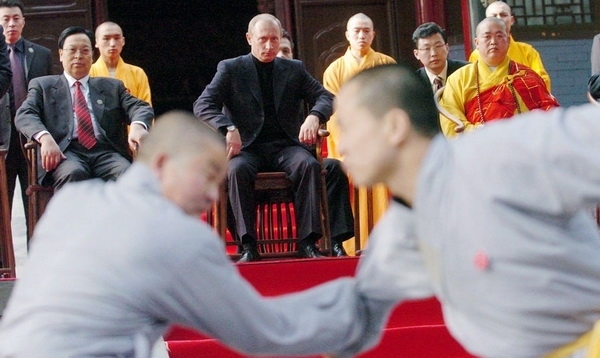

By Liu Jinsong (刘金松)
Nation, page 9
Issue No. 549, Dec 19, 2011
Translated by Zhu Na
Original Article: [Chinese]

Russia's former President Vladimir Putin watches a matrial arts display at Shaolin alongside the temple's leader Abbot Shi in 2006.
Shaolin Temple and the local government in Henan have been working together for years to build a profitable brand around the fifth-century monastery whose monks were among the earliest masters of Kung Fu.
Their efforts have helped make the temple famous worldwide, drawing 1.5 million tourists to Shaolin each year, as well supporting the surrounding area. However, the government and the monks are now at loggerheads about what to do with the profits.
With each visitor paying 100 yuan, ticket sales raise 150 million yuan a year, but the temple gets just 30 percent of this, with the remainder divided between the local government and its corporate partner.
As well as admissions fees from tourists visiting the temple, the community of Dengfeng also benefits from the students who study at the nearby martial arts schools and spend around 500 million yuan a year. There are another 200 businesses in the area generating some 100 million yuan from the sale of martial arts equipment, teaching aids and souvenirs.
When it comes to ticket sales, it’s not the temple that is in control.
“How many tickets were sold in the end? And how many people get free tickets? They [the site managers] have the final say. How much we are given depends on them,” the temple's leader, Abbot Shi Yongxin, has said.
When officials from the temple ask the site managers about the publicly announced visitor statistics, they’re told that those figures are overestimates, published for propaganda purposes.
Outside the temple, each attraction belongs to a different interest group. For example, Songshan (嵩山) Shaolin Temple Martial Arts Training Centre, where tourists watch the Shaolin Kong Fu show, belongs to the Henan Province Tourism Bureau, as does a nearby Buddhist style hotel.
Opposite the temple are the Buddhist Living Quarters (十方禅院), home to 500 Arhats. Tourists wanting to pass through must pay 10 yuan, which goes to the project’s investors, the commerce bureau of Dengfeng County and Zhengshou City Salt Company.
Nearby, the Kung Fu schools charge 10,000 yuan to 16,000 yuan a year for full-time students, and $30 for foreigners who want to spend a day improving their footwork and upper-body techniques.
Shaolin Temple is a registered trademark, but the abbot has resisted calls to protect the name from being used by others.
“Running martial arts training schools is also a way of promoting Shaolin culture, we cannot stop their business,” says Shi.
In fact, with the temple’s reputation already damaged by its commercialization, the abbot might simply be afraid that enforcing the rights to the Shaolin name would open the temple up to accusations of acting like a monopoly.
After the Shaolin site was renovated in 2000, unhappy villagers besieged the temple and local government departments received reports that Abbot Shi had been using prostitutes. The abbot complained of a campaign to blacken his name, and officials visited the temple to investigate.
In the early stage of Shaolin’s development as a tourist site, the temple and the local government cooperated together closely. However, commercial success has driven a wedge between the two sides, with Abbot Shi seeking to use the temple’s wealth to promote its Buddhist values while the government tries to expand the commercialization. For one side, the temple is just a driver for the local tourist industry, for the other it’s a Buddhist shrine.
These conflicting priorities have produced some curious scenes, such as the occasion when competing beauty queens toured the temple in bikinis, while the monks, on Abbot Shi’s orders, were banned from observing. To make up for the reclusive monks, the organizers of the contest invited in some martial arts students with shaven heads and got them to greet the bikinied models by the temple gate.
There are also peculiarities in the relative status of the abbot and his partners in the local government.
Early in the site’s development, Shi would have to wait a day in the local government office before being granted an audience with an official, but when Vladimir Putin visited in 2006, top province officials were in the second row while Shi and Putin, who was then Russian president, were sitting side by side.
The clearest divergence between Shi and the cadres came when the abbot wanted to stop charging visitors to enter the temple. The local government had been looking forward to a windfall from listing its Shaolin tourist operations on the stock market, and the mainstay of that business was the income from ticket sales. The abbot blocked the IPO, but the government insisted that the temple keep charging visitors 100 yuan to see inside the temple.
Links
The Financial Times Lunch with the FT: Shi Yongxin
This translation was edited by Will Bland

